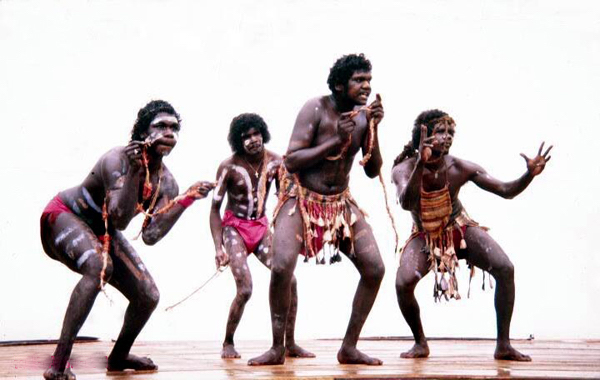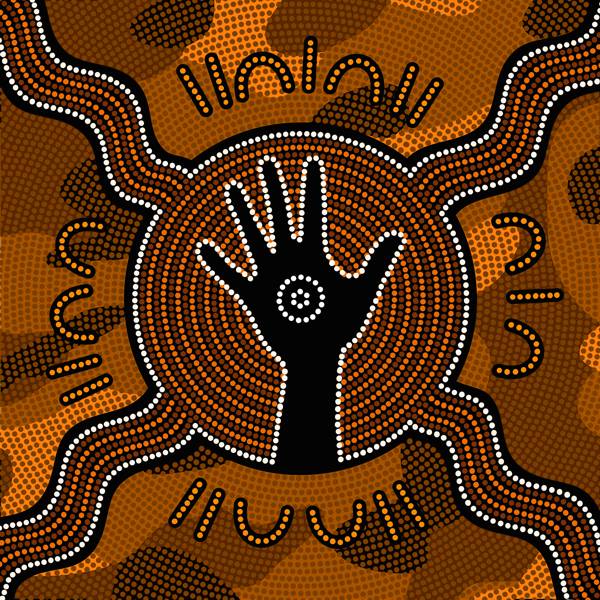Aboriginal Australian Culture and Music

Of all the cultures we've reviewed this semester, I am surprised that we didn't learn about Aboriginal Australians. The Aboriginal people of Australia are people that migrated from Asian countries such as Malaysia, Singapore, Indonesia, the Philippines, Brunei, and East Timor. Together they combined their cultures and became the indigenous people of Australia. Their religion/mythology is Dreamtime/ the dreaming songlines. The Aboriginal dreamtime is the main part of their culture. The dream catcher is one of the items that stems from Dreamtime. Dream catchers were originally created for babies for protection when they slept to protect them from evil spirits. They were also used as mobiles to “entertain” babies.
Music
The main instrument they use is the Didgeridoo. The didgeridoo is an aerophone or wind instrument that is made of hollowed wood. It doesn’t have any holes alongside it, and it is blown through by using a mouthpiece. It is able to replicate the sounds of nature such as wind, animals, and water flowing. Like the Indigineous people of North America, the Aborigines are also very resourceful. The Didgeridoo is made by selecting trees from appropriate locations usually in the Northern parts of Australia. Usually, an aboriginal craftsman taps the trees to see if it is hollow and the suitable trees are cut down. Then they clean the tree, because termites leave residue in the hollowed out tree which needs to be removed in order to play the instrument. They do this by soaking the wood in water then scraping the residue out with a stick or some coals.
The outside bark is then removed and the stick is checked for holes (holes being in the hollowed out tree will alter the sound). After that, the stick is sealed from air at both ends and dropped in water. If bubbles are detected while the sealed stick is in the water then the holes are sealed with beeswax. The mouthpiece that’s carved is then covered with beeswax so it’ll have a smoother surface to place your lips on. Depending on the artist, the didgeridoo is decorated with symbols and paintings on the outside. Most of the paintings relate to their religion or a common theme of their music.
Another instrument that is used is the Bull-roarer. The bull-roarer is a 4-15 inch piece of flat wood attached to a string. It makes noises similar to those of the didgeridoo, and it’s played by being swung. While it does use space and air to produce noise, it isn't considered a normal aerophone. The bull-roarer is categorized as a free aerophone, since it's swung in open space. The instrument is primarily played at men’s initiation ceremonies. The ceremonies usually consisted of a circumcision, and cutting a man’s chest, shoulders, and butt. In order to leave larger scarring, the wounds are filled with sand. The same goes for female initiation ceremonies. The only difference is that the girl gets her butt cut. Afterwards, those who were initiated are considered eligible bachelors and bachelorettes.

Australian music has many genres of music. One of the genres is Indie-Pop. Emily Wurramara is a famous Indie-pop artist. She was nominated for the best blues and roots album at the ARIA awards. She has a lot of music that falls under the contemporary category as well. A popular band named Yothu Yindi is known for combining cultures and sounds to make interesting songs. They don't only collaborate with bands from different cultures but they also use instruments from different cultures.
Clothing
Another major part of Aboriginal culture is their clothing. Many people didn't wear clothes unless the weather required them. When they did wear clothes, they wore animal skins. They called the animal skins they wore "cloaks." Their cloaks mainly kept them warm during frigid winters. Their cloaks were made from platypus, kangaroo, and possum. The cloaks were mainly worn by the Koori people. After years of using animal skins, the government out-ruled the cloaks and replaced them with wool blankets. After that rule was implemented, many people died from the cold. The skins weren't only made for cloaks, they were also used for belts, skirts, and loin cloths. 
Art
Aboriginal art comes in many forms. They use body art, rocks to create art, and different tree barks for their art. They use different clays, paints, and other natural resources to paint and/or stain items. They also use watercolor to make art on canvases that are easily stained or light in color. Up until the 1970s, watercolor was the primary medium. While some art is abstract, they do have a lot of art with spiritual meanings. The dreamcatchers that were previously mentioned are also forms of art. Some people enjoyed making them for children in the family.

Works Cited
“Aboriginal Culture: Learn about Aboriginal Culture & Identity.” Australians Together, https://australianstogether.org.au/discover/indigenous-culture/culture-identity/.
Australia, SBS. “Aboriginal Clothing.” SBS Your Language, 9 Jan. 2017, https://www.sbs.com.au/language/english/aboriginal-clothing.
“Australian Aboriginal Peoples.” Encyclopædia Britannica, Encyclopædia Britannica, Inc., https://www.britannica.com/topic/Australian-Aboriginal.
Callan, Paris Donnatella. “The Best Indigenous Singers and Bands in Australia.” Culture Trip, The Culture Trip, 7 Dec. 2017, https://theculturetrip.com/pacific/australia/articles/the-best-indigenous-australian-singers-and-bands-you-should-know/.
“The Didgeridoo and Aboriginal Culture.” Aboriginal Art & Culture Alice Springs Australia, https://www.aboriginalart.com.au/didgeridoo/what_is.html.
“Dreamcatcher Origins.” AGA AZRA, https://www.agaazra.com/dreamcatcher-origins.
Koorihistory.com. “Possum Skin Cloak, Animal Skins - Traditional Aboriginal Clothing.” Koori History - Aboriginal History of South Eastern Australia, 20 Jan. 2020, http://koorihistory.com/traditional-aboriginal-clothing/.
“Music, Dance and Art.” DevelopmentEducation.ie, 20 Nov. 2020, https://developmenteducation.ie/feature/a-focus-on-aboriginal-australia/music-dance-and-art/.
“Traditional Sociocultural Patterns.” Encyclopædia Britannica, Encyclopædia Britannica, Inc., https://www.britannica.com/topic/Australian-Aboriginal/Traditional-sociocultural-patterns.
“The UNAMBAL.” Bradshaw Foundation, https://www.bradshawfoundation.com/unambal/index.php.
“What Is Aboriginal Dreamtime?” Artlandish Aboriginal Art Gallery, 13 Oct. 2021, https://www.aboriginal-art-australia.com/aboriginal-art-library/aboriginal-dreamtime/.

Hey Chanaya, I also loved learning about the aboriginal people. The digeridoo is also a very fun word to say and a beautiful instrument.
ReplyDeleteHi Chanaya!! I sadly missed the day in class where we learned about Australia. So I really loved your blog!! The aboriginal culture is so beautiful and we should be taught about it more.
ReplyDeleteI really like how you mentioned the aboriginal people. I have never heard of those people and the music and the instruments that come along with it makes the people and the music unique.
ReplyDeleteReading about the dream catcher from you really piqued my interest and forced me to go on my own little research hunt on the origins and the mythology of their religion and I'll say it was definitely fascinating.
ReplyDeleteLearning some of about the Australians was probably my favorite topic to learn about. it was really fun to learn about how close and connected they are to the earth. I not only love their accents but I love learning about their culture just as much.
ReplyDeleteLearning about the indigenous Australians is always interesting. I think it is cool they invented the digeridoo. The fact they created it is their claim to fame in my opinion because of the popularity of the instrument in todays time.
ReplyDelete